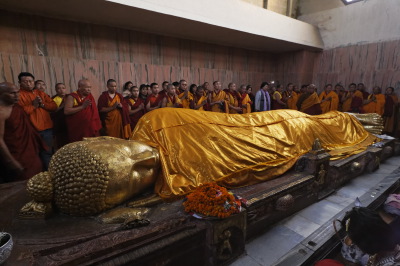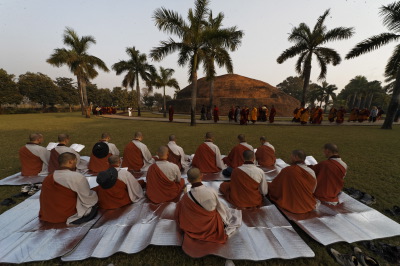Kushinagar is the place where Buddha Shakyamuni entered ‟Mahaparinirvana”, the ‟great transcendence of suffering”. When he reached his eighty-first year, the Buddha gave teaching at the Vulture’s Peak of Rajgir, and went north with his nephew to Nalanda and then Vaishali, a place where he often stayed and where he had given teachings on the ultimate truth and where he gave, too, one of his last teachings.
As the Buddha came to a place called Pava, Kunda, the son of a blacksmith, offered him a meal that included meat. The Buddha accepted the meal, but told that no one else should partake of the food. The reason was that the meat was bad and provided the circumstantial cause for the Buddha’s sickness. The time had come for the Buddha to leave this world even though he had the capacity to prolong his life. He told Ananda that the merit created by offering an enlightened one his last meal is equal to that of offering food to him just prior to his enlightenment.
When the Buddha and his followers arrived at Kushinagar, the Buddha proceeded to a grove of Sala trees that belonged to a caravan leader merchant devoted to the Buddha. There, between two pairs of unusually tall trees, Shakyamuni lay down on his right side in the lion posture with his head facing to the north.
When the Buddha was asked why he had chosen Kushinagar to pass away, he replied that there were three reasons. The first one was that Kushinagar was the proper venue for teaching the Maha-Sudassana Sutra.
The second one was a person, named Subhadda, to whom the Buddha still needed to give teaching and who consequently became an Arhat. The third one was that there was in Kushalnagar a wise and respected old Brahmin, called Doha, who could mediate among all the disciples and Kings who would inevitably argue on how to share the Buddha’s relics.
The noblemen of Kushinagar, informed of the Buddha’s impending death, came to pay him respect. Among them was Subhadra, a 120-year-old Brahmin who was much respected, but whom Ananda had turned away from the monkhood three times. However, the Buddha called the Brahmin to his side, answered his questions concerning the six erroneous doctrines, and revealed to him the truth of the Buddhist teaching. Subhadra asked to join the Sangha and was thus the last monk to be ordained by Shakyamuni. Subhadra then sat nearby in meditation, swiftly attained arhatship and entered Parinirvana shortly before Shakyamuni.
As the third watch of the night approached, the Buddha asked his disciples thrice if there had any remaining queries concerning his teachings or the rules of discipline. Receiving silence, he gave them the famous exhortation: ‟Impermanence is inherent in all things. Work out your own freedom with diligence.” Then, passing through the meditative absorptions, Shakyamuni Buddha entered Mahaparinirvana. The earth shook, stars shot from the heavens, the sky in the ten directions burst forth in flames and the air was filled with celestial music. The master’s body was washed and robed once more, then wrapped in a thousand shrouds and placed in a casket of precious substances.
For seven days, offerings were made by gods and men, after which, amidst flowers and incense, the casket was carried to the place of cremation in great procession. A pyre of sweetly scented wood and fragrant oils had been built but even though several disciples tried to light it, it would not burn. A disciple of the Buddha, who had clairvoyance, told that this was because the great disciple Mahakasyapa was marching on his way, with 500 students, to pay homage to the Buddha’s body, and that the fire would not start until he had arrived. In fact, when Mahakakyapa eventually came, offered prostrations and paid his respects, the pyre burst into flames spontaneously.
After the cremation had been completed the ashes were examined for relics. Only a skull bone, teeth and the inner and outer shrouds remained. The Mallas of Kushinagar first thought themselves most fortunate to have received all the relics of the Buddha’s body. However, representatives of the other eight countries that constituted ancient India also came forth to claim them. To avert a conflict, as foretold by the Buddha, the Brahmin Drona suggested an equal, eightfold division of the relics between them. The eight peoples each took their share to their own places and the eight great stupas were built over them. In time, these relics were again subdivided after Ashoka had decided to build 84,000 stupas. Today they are contained in various stupas scattered across Asia.
Today, at the place where the Buddha passed into Parinirvana, in a beautiful park stands a modern shrine erected by Pandit Nehru, housing a large recumbent white statue of the Buddha (see photograph), which had been installed at Kushinagar by the monk Haribhadra during the reign of King Kumaragupta (415-56 CE), the alleged founder of Nalanda Monastery. When discovered late in the last century, the statue was broken but it has now been restored. A few hundred meters away, on finds the ruins of a large stupa, now called Ramabhar, which marks the place of the cremation.

